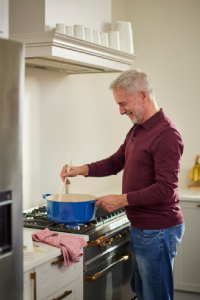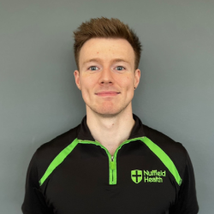Free ways to exercise and build movement into your day
- Overview
Why is movement so important?
Movement comes in all shapes and sizes and works wonders for our mental and physical health. Getting up and moving about will always be one of the best things we can do for our mind and body.
Worldwide, it’s estimated that 1 in 3 women and 1 in 4 men don’t do enough physical activity to stay healthy. To get an idea of how beneficial regular exercise and movement can be, the NHS advise that regular exercise can help lower our risk of early death by as much as 30%.
The best thing about physical activity is that it doesn’t have to be intense. No matter what your condition or physical ability, there are ways you can introduce movement into your daily routine to improve your overall health and wellbeing.
What counts as exercise?
This is a great question.
If you’re looking for ways to build movement into your day, you’ve probably read about ‘light’, ‘moderate’, and ‘vigorous’ activity. Whilst this might sound a bit vague, it’s actually fairly straightforward.
These terms refer to how much effort you put in and how your body reacts to that effort. This will naturally differ from person to person depending on factors like your size, weight, age, and physical ability.
Free ways to get moving outside
Walking
Taking a brisk walk is a low-impact way to get your heartrate up without putting undue stress on your joints.
The best part is that you don't need special equipment or a gym membership. Just find a safe and stable path to walk on and make sure you’re wearing a comfortable pair of shoes.
Looking for creative ways to boost your step count?
- Get off the bus or tube one stop early
- Take a walk on your lunch break
- Choose the stairs instead of the lift
- Climb the escalator instead of standing
- Watch television at home on a walking pad
- Use a step counting app and challenge friends to beat your daily step count
- Take a work meeting on the move
- Extend your daily dog walk by 15 minutes
Getting active with your children at home

Kids are rarely happier than when their parents are actively interested and involved in what they’re doing.
Getting active with your children isn't just fun for them – it's a fantastic way to introduce more movement and exercise into your day. When you play together, you’re having fun as a family and building core memories for them whilst keeping yourself young.
Whether it's running, jumping, climbing, or dancing, active play naturally involves a lot of movement. These activities will help increase your heart rate, improve circulation, and strengthen joints and muscles, all while having a great time.
See below for some great ways to get even more out of playtime:
- Build games around your play
- Walk to and from the park instead of driving
- Host a “family Olympics” at home
- Have a dance party
- Build a fort
- Host a sports day
- Play catch or hide and seek
- Limit their time on the sofa and get moving with them
- Get involved with a treasure hunt in the garden
Going for a walk on your lunch break
Working in an office can make it harder to get your daily steps up as you're sat down for most of the working day. Sedentary behaviour and long periods of inactivity are linked with higher blood pressure, stiffness, postural problems, and an increased risk of a heart attack or stroke.
Taking regular trips to the water fountain to refill your water bottle is one way to get more steps, or perhaps putting one day a week aside where you avoid the temptation of a team lunch and take a walk instead.
Invite your coworkers along and get some fresh air whilst exploring the local area. Your step-counter will thank you, and you’ll feel more motivated and clear-headed when you go back to work in the afternoon.
Walking the dog
It’s no secret that dogs make great training partners.
Having a furry friend in the house gives you round-the-clock access to a workout buddy who’ll never say no to getting some extra steps in.
Come rain or shine, venturing outdoors with your canine companion isn’t just good for them. Studies have shown that dog owners tend to have lower blood pressure, reduced stress levels, and improved overall well-being compared to non-dog owners.
By simply walking your dog for the recommended minimum of 30 minutes per day, you can both clock up three and a half hours of walking time per week. If you’re looking to do more, extending each brisk walk by just 15 minutes will add over an hour and a half to your weekly exercise routine.
Free ways to get moving at home
Stretching on the sofa or in your chair
When we get home, there’s something great about sitting on the sofa and relaxing, but being in a sedentary position for long periods can have a detrimental effect on our overall health.
Aside from problems with circulation, it can negatively affect posture and build stiffness into our joints. Thankfully, there are several stretches and movements you can do whilst sitting down to help combat this.
These are great for reducing stress and strain on our joints and can be done whilst sitting down:
- Chin tucks
- Ankle circles
- Circular neck rolls
- Shoulder blade rolls
- Crunches
- Pelvic tilt
- Hamstring stretches
- Figure 4
Regardless of your current ability, you can start building on this over time. One way to do this is to use some light weights (1kg or 2kg) or a resistance band to add some gentle resistance to these movements.
Yoga and Pilates
Yoga and Pilates are all about finding movements that improve core strength, flexibility, and balance.
Following our getting started with yoga guide is a great way to find movements that feel good and work for you and your body. Whilst the slow pace might not immediately feel like exercise, it’s a great way to build muscle and endurance without putting massive amounts of stress on your joints.
A great way to get started is to follow along with one of our beginners yoga sessions at home.
If you’re looking for some beginner-friendly poses to try at home, take a look below:
- Child’s pose
- Downward facing dog
- Low lunge
- Cobra
- Chair
- Warriors pose
- Pigeon pose
- Cat/cow
- Bridge
Exercising as you scroll
If sitting still and scrolling on your phone sounds familiar, try introducing one of the movements below to boost circulation and distract yourself from your phone for a bit.
All of these exercises can be done whilst you’re chatting with friends, scrolling through social media or catching up on breaking news. As they’re low-intensity, you’ll even be able to do some of them whilst you’re on the phone.
- Standing leg raises: stand up straight and lift one leg straight out in front of you. Hold for a few seconds, then lower it back down
- Calf raises: while standing, raise up onto the balls of your feet, hold for a moment, then lower back down
- Shoulder shrugs: sit or stand with your shoulders relaxed. Lift both shoulders towards your ears and hold for a moment before releasing
- Seated leg extensions: while sitting, straighten one leg out in front of you, hold for a moment, then lower it back down
- Neck stretches: tilt your head to one side, bringing your ear towards your shoulder and hold for a few seconds. Repeat on the other side. You can do this while seated or standing
- Hand grips: squeeze a stress ball or grip strengthener in one hand while you scroll with the other
- Abdominal contractions: while sitting or standing, contract your abdominal muscles by pulling your belly button towards your spine and hold for a few seconds
- Wall sits: find a clear wall space, lean against it, and slide down until your knees are bent at a 90-degree angle
- Plank: get into the traditional plank position on elbows and toes, keeping your body straight. Place your phone on the ground underneath you and make sure to keep your spine neutral spine as you engage your core muscles.
Cleaning
The physical advantages of cleaning shouldn’t be ignored. The continuous movement, bending, and stretching involved can elevate our heart rate and engage muscles we might not be used to using.
As with most physical activity, it’s the intensity and effort that counts. Whether you're tackling the kitchen sink or vacuuming the living room, it's crucial to keep the intensity up if you want to make cleaning part of your daily movement routine.
Research suggests that engaging in vigorous cleaning for approximately an hour can be comparable to completing a 20-minute low-impact workout. On top of this, the satisfaction and results will give you a nice little mental boost when you’re finished!
Dancing
To get started, clear a space at home where you can move freely without issue.
Choose some of your favourite songs or put on a playlist with some upbeat tunes that make you want to get moving. You could start with a dynamic warm-up to prepare your muscles and joints for movement or get right into it if you’re ready to go.
Dance like nobody's watching and within a couple of tracks, you'll have worked up a sweat without realising it. If you’re looking for something more structured, there are plenty of online platforms where you can follow along with dance workout videos led by professional instructors.
Get moving when you do the dishes

As with any menial task you do at home (cleaning, doing the washing up, ironing), taking regular breaks and setting yourself little tasks to do along the way can help build movement into an otherwise boring activity.
Take note of how your body feels when you’re stood at the sink and stretch yourself before, during, and after to help loosen your back and hips. Quickly scan your body and target any aches and pains you notice to make standing still more comfortable.
A good place to start is to think in numbers. Set yourself a goal that works for you, along the lines of:
- “For every plate I wash, I’ll do two squats”
- “When I’m ironing, I’ll do five t-shirts then a set of press-ups”.
- “I’m going to test my balance whilst mopping by balancing on one leg”
These activity boosters quickly add up.
Remember, the movements you choose should be challenging but manageable, so experiment and find what works for you. They’re designed to make sedentary tasks a bit more fun and get you moving in creative and challenging ways.
Taking regular desk breaks
Working from home can mean sitting in one position for hours on end. Unlike the office where colleague interactions and meetings force us to get up and move about, everything we need to get done when working from home can be done at our desk.
Taking regular breaks to stretch, walk around our house or flat, and get our heartrate up can have a positive impact on stiffness and blood flow. Sometimes, all it takes is a 5-minute movement break to reset things. Chances are, you’ll also notice your concentration and focus improve when you take one of these short breaks away from your laptop or computer.
If you’re unsure of how to get the most out of a five minute break, try our 5-minute office workout. Alternatively, see below for more inspiration:
- Roll your shoulders to prevent rounding
- Stand up and touch your toes
- Stretching your hamstrings and glutes
- Use a resistance band to loosen your shoulders
- Doing press-ups or sit-ups every hour
- Loosening your hips with Pilates and yoga poses
- Taking a long walk at lunch
- Walking upstairs to loosen things up
- Squats
Exercising with a disability
Exercising with a physical disability can be challenging for several reasons, not only in terms of physical ability, but because of the additional mental effort that can be required to get started. Luckily, there are lots of ways you can incorporate movement into your day-to-day life as a disabled person or someone facing additional physical barriers to exercise.
Working with your GP or healthcare provider (who has a good understanding of your condition) is an excellent place to start. They’ll be able to talk through your goals and make sure the movement regime you choose matches your condition without being detrimental to your health.
At home, there are thousands of accessible exercise classes widely available on YouTube, as well as helpful resources available from organisations like Activity Alliance, Disability Sports Coach, Inclusfit, Sense and British Blind Sport. We also have a number of workouts available on our Nuffield Health 24/7 platform that you can follow along with at home and adapt to meet your ability.
The mental toll of living with a long term disability can be a huge barrier that prevents many people getting started with movement and exercise. While you may face more challenges exercising as a disabled person, you will also reap enormous benefits. Many people see enormous improvements to pre-existing conditions by introducing a regular movement routine (that suits them and their condition) into their daily routine.
Build on what you’re already doing
Slowly building things up over time is a great way to stay motivated and keep your body excited about movement.
You can do this by increasing volume and the amount of time you spend moving and exercising, or by starting a new routine that includes a bit of intense exercise. How you go about building on your current level of movement will all depend on what you’re currently doing and how your body reacts to exercise.
If you’re unsure of what this might look like, try:
- Increasing the duration of your exercise
- Increasing the amount of reps you’re doing
- Adding more steps to your target for the day
- Add weights to your movements for added resistance
- Gently introduce some manageable Pilates and yoga poses
Be kind to yourself

Remember that big change doesn’t happen overnight. Results and improvements to our overall health are the result of small changes we make every day that slowly become part of our everyday routine.
Unfortunately, with new habits come days when we can’t keep to our new schedule. This is to be expected and shouldn’t be cause for concern. Life can get busy from time to time and adjust our priorities without our say so.
The most important thing is that we don’t lose sight of the bigger picture. Introducing small and manageable movement-focused changes into our day (that work around our schedule) can make us feel more capable of dealing with stressors when life does get busy.
Encourage others and work together
Whether you’re step counting or exercising at home, doing it with someone else is a great way to get accountable and stay motivated. We also tend to feel more comfortable trying new things if we do them with someone we know and trust.
Some great ways to do this are:
- Buddying up with a friend to try something new
- Setting up a movement-focused group chat
- Talking about movement and exercise with friends and family
- Checking in and staying accountable
- Leading by example
- Starting a group at work or with other parents at school
Last updated Monday 15 April 2024
First published on Monday 15 April 2024

